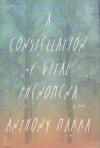A Constellation of Vital Phenomena
Against the background of bad press about Chechnya—from violent rebel attacks like that on a Moscow theater and, more recently, the Chechen connection with the Boston Marathon bombers—Anthony Marra’s novel A Constellation of Vital Phenomena manages to right the balance on Chechen/Russian violence. For those of us who know little about the Chechens’ struggle for independence, from the first page on, we see the brutality of the “Feds” (the Russians) and their continuing efforts to obliterate any chance of the country’s unification. The two main female characters, sisters Natasha and Sonja, are Russians; their family was encouraged to move to Chechnya to help keep the country Russian.
Against the background of bad press about Chechnya—from violent rebel attacks like that on a Moscow theater and, more recently, the Chechen connection with the Boston Marathon bombers—Anthony Marra’s novel A Constellation of Vital Phenomena manages to right the balance on Chechen/Russian violence. For those of us who know little about the Chechens’ struggle for independence, from the first page on, we see the brutality of the “Feds” (the Russians) and their continuing efforts to obliterate any chance of the country’s unification. The two main female characters, sisters Natasha and Sonja, are Russians; their family was encouraged to move to Chechnya to help keep the country Russian.
The novel is, however, a human story, not a political one. The plot involves five Chechen neighbors barely surviving the violence in a hamlet damaged by war, plus an 8-year-old child, Havaa, who needs protecting after the Feds take away her father and burn their home. Not far away, one of the Russian sisters, the doctor Sonja—really the only doctor—works in the area’s safest place, the ill-equipped hospital. Akhmed, a friend of Havaa’s father, Dokka, brings her to Sonja for shelter, and Sonja immediately hires him as a doctor out of extreme need. Sonja’s own desperation, the reason she returned to Chechnya from London, comes from her sister Natasha’s disappearance.
The novel’s structure and beautiful writing do much to make the reader feels the characters’ pain and final exultation. Amazingly, the main chronological events take place in only five days in 2004. But Marra, starting then, zigzags back repeatedly between 1994-2004, interrupting the linear progression to fill in why certain things happen. The message seems to be that there are painful, often horrendous repercussions for one’s actions. Eventually we get the full powerful picture, with its devastating effects on the characters.
Akhmed has to leave his invalid and demented wife to travel carefully around patrols in order to work in the hospital and see Havaa. The details of his care for his wife, Ula, tell their sad story:
When he . . . stripped the linens from the mattress, he found her tawny silhouette sweated into the fabric. The musky darkening was so particularly, irrevocably Ula that he would hesitate to wash it. But then, scolding himself for being sentimental, he would fill the basin with soapy water and submerge her outline and watch her disappear. He was losing her incrementally. . . . As a web is no more than holes woven together, they were bonded by what was no longer there.
The oldest neighbor, Khassan, wrote a complete history of Chechnya but was allowed to publish only the first book, Origins of Chechen Civilization: Prehistory to Fall of the Mongol Empire. He does not talk to his son, the informer Ramzan, who caused the gentle and kind Dokka to be taken away by the Feds. Khassan, also a humane person, takes care of feral dogs left behind by “disappeared” neighbors. Burning the rest of his manuscripts, he decides on one final writing, which turns the tide at the novel’s end:
Not a history of a nation that had destroyed history and nationhood. Something smaller. A letter to Havaa. His recollections of Dokka, his favorite memory, then go back to the first time he had met him, and end with Havaa’s birth. It would be the first true thing he had ever written.
This is a world of secrets—Khassan’s and Akhmed’s—and even the tormented Ramzan’s understandable reasons for becoming an informer. But the “national industry” is “disappearances,” here experienced by Sonja:
At the kitchen table she examined the glass of ice. Each cube was rounded by room temperature, dissolving in its own remains, and belatedly she understood how a loved one disappeared. Despite the shock of walking into an empty flat, the absence isn’t immediate, more a fade from the present tense you shared, a melting into the past, not an erasure but a conversion in form, from presence to memory, from solid to liquid, and the person you once touched now runs over your skin, now in sheets down your back, and you may bathe, may sink, may drown in the memory, but your fingers cannot hold it.
The novel’s title comes from The Medical Dictionary of the Union of Soviet Physicians: “Life: a constellation of vital phenomena—organization, irritability, movement, growth, reproduction, adaptation.” This is ultimately a story of life prevailing. Neighbors find love: “For months they’d run their fingers around the hem of their affections without once acknowledging the fabric. . . . She was his home. The only land that bound him.” Characters grow and adapt. “Maybe we find them [the people we love] in other people. In kindness and generosity, those things don’t disappear.” Thus there is no surprise at the “spinning joy” at the end of this powerful, beautifully written novel.





